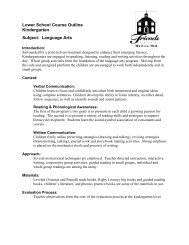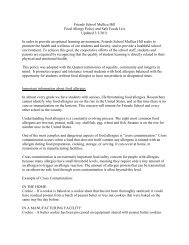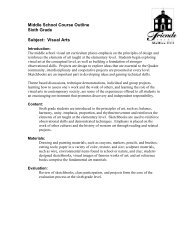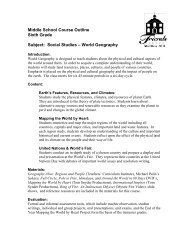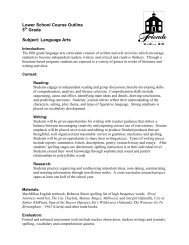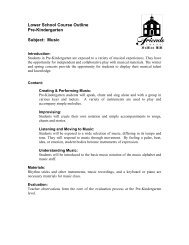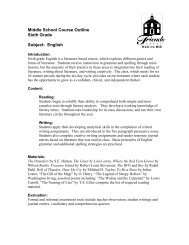Middle School Course Outline Seventh Grade Subject: Music
Middle School Course Outline Seventh Grade Subject: Music
Middle School Course Outline Seventh Grade Subject: Music
You also want an ePaper? Increase the reach of your titles
YUMPU automatically turns print PDFs into web optimized ePapers that Google loves.
<strong>Middle</strong> <strong>School</strong> <strong>Course</strong> <strong>Outline</strong><br />
<strong>Seventh</strong> <strong>Grade</strong><br />
<strong>Subject</strong>: <strong>Music</strong><br />
Introduction:<br />
In the course titled <strong>Music</strong>: Elements and Applications, seventh grade students will<br />
experience music as an active, informed listener. They will explore a variety of music<br />
while singing and clapping tonal and rhythmic patterns. They will apply this knowledge<br />
to their vocal and instrumental performance experiences as well as relating it to other<br />
disciplines and cultures.<br />
The <strong>Middle</strong> <strong>School</strong> Spring <strong>Music</strong>al and concerts provide the opportunity for students to<br />
display their musical talent and knowledge.<br />
Content:<br />
Creating & Performing <strong>Music</strong>:<br />
Students who participate in the <strong>Middle</strong> <strong>School</strong> Spring <strong>Music</strong>al will sing vocal<br />
selections with expression and technical accuracy.<br />
Improvising & Composing:<br />
Students will create and arrange music to accompany readings or dramatizations.<br />
Listening to <strong>Music</strong>:<br />
Students will be exposed to the general sense of form in ethnic (folkloric) music,<br />
popular music, jazz, and classical music.<br />
Understanding <strong>Music</strong>:<br />
Students will learn musical motives (ideas) as combinations of tones and rhythms<br />
and behave in musical phrases. Students will identify and define standard<br />
notation symbols for pitch, rhythm, dynamics, tempo, articulation, and<br />
expression.<br />
Materials:<br />
Rhythmic instruments, music recordings, and a keyboard or piano are necessary materials<br />
for music class.<br />
Evaluation:<br />
Formal and informal assessment tools include teacher observation, listening quizzes, and<br />
written assignments.
<strong>Middle</strong> <strong>School</strong> <strong>Course</strong> <strong>Outline</strong><br />
Eighth <strong>Grade</strong><br />
<strong>Subject</strong>: <strong>Music</strong><br />
Introduction:<br />
In the course titled <strong>Music</strong>: Elements and Applications, eighth grade students will<br />
experience music as an active, informed listener. They will explore a variety of music<br />
while singing and clapping tonal and rhythmic patterns. They will apply this knowledge<br />
to their vocal and instrumental performance experiences as well as relating it to other<br />
disciplines and cultures.<br />
The <strong>Middle</strong> <strong>School</strong> Spring <strong>Music</strong>al and concerts provide the opportunity for students to<br />
display their musical talent and knowledge.<br />
Content:<br />
Creating & Performing <strong>Music</strong>:<br />
Students who participate in the <strong>Middle</strong> <strong>School</strong> Spring <strong>Music</strong>al will sing vocal<br />
selections with expression and technical accuracy.<br />
Improvising & Composing:<br />
Students will create and arrange music to accompany readings or dramatizations.<br />
Listening to <strong>Music</strong>:<br />
Students will make stylistic comparisons of ethnic (folkloric) music, popular<br />
music, jazz, experimental, and classical music.<br />
Understanding <strong>Music</strong>:<br />
Students will learn musical motives (ideas) as combinations of tones and rhythms<br />
and behave in musical phrases. Students will identify and define standard<br />
notation symbols for pitch, rhythm, dynamics, tempo, articulation, and<br />
expression.<br />
Materials:<br />
Rhythmic instruments, music recordings, and a keyboard or piano are necessary materials<br />
for music class.<br />
Evaluation:<br />
Formal and informal assessment tools include teacher observation, listening quizzes, and<br />
written assignments.



